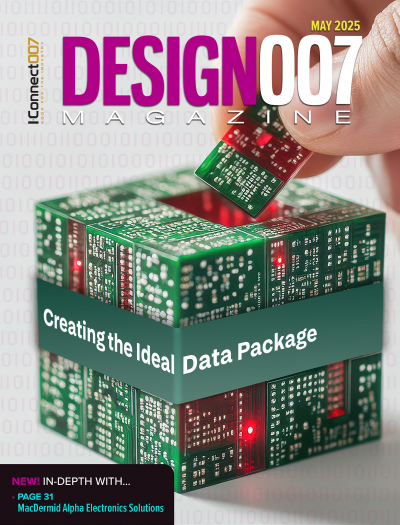-

- News
- Books
Featured Books
- design007 Magazine
Latest Issues
Current Issue
Showing Some Constraint
A strong design constraint strategy carefully balances a wide range of electrical and manufacturing trade-offs. This month, we explore the key requirements, common challenges, and best practices behind building an effective constraint strategy.

All About That Route
Most designers favor manual routing, but today's interactive autorouters may be changing designers' minds by allowing users more direct control. In this issue, our expert contributors discuss a variety of manual and autorouting strategies.

Creating the Ideal Data Package
Why is it so difficult to create the ideal data package? Many of these simple errors can be alleviated by paying attention to detail—and knowing what issues to look out for. So, this month, our experts weigh in on the best practices for creating the ideal design data package for your design.
- Articles
- Columns
- Links
- Media kit
||| MENU - design007 Magazine
Reliability and Harmonization of Global Standards at Forefront of EIPC Efforts
March 18, 2015 | Pete Starkey, I-Connect007Estimated reading time: 7 minutes
Weinhold: Well I think we have to go back a few years. The IEC standards were built around the national standards from Britain, Germany, and other countries. Then in the late 70s, IPC got involved and Dieter Bergman did an outstanding job at harmonizing the IEC and the IPC standards over many years. Now, we don't see this kind of harmonization any more, and it could lead to the point where these standards are drifting away from each other, which is not good for the industry in general. So new standards, for example IEC standards, are proposed by the Asian countries which represent approximately 90% of the global PCBs that are manufactured. So, we could easily lose leadership if we don't make an effort to harmonize these standards.
Starkey: I understand. Thank you, Michael. Alun, you have another EIPC conference coming up in the summer. Where will this be, and what will be the main focus?
Morgan: It will be in June in Berlin, I believe the 18th and 19th of June. We've organized a visit to the Fraunhofer Institute's new laboratory, which Michael visited in December last year. It is very impressive and has been totally rebuilt.
Starkey: This is where a lot of innovations originated, particularly in embedded component technology.
Morgan: Absolutely. Professor Lang has been really instrumental in bringing these advancements on. And they have really an extremely comprehensive laboratory there, especially in terms of signal integrity testing, which is another theme that we're very interested in following. So I think we will certainly have that as a major theme. We chose Berlin for two primary reasons. One, it's easily accessible. It's also in Germany, which is where, say, 47% of the PCBs in Europe are made, so this is a good location for the local market. And secondly, we were able to get the visit with Fraunhofer, which is going to mean so much to our organization and to our industry over the years. It's brought many, many projects out of the research laboratories into really practical applications, and I think that's something we should be very grateful for.
Starkey: Alun and Michael, it's been nice to talk to you. Thank you very much indeed for your time. Have an enjoyable show and have a successful next EIPC conference.
Video from EIPC Winter Conference, Munich 2015
Suggested Items
Happy’s Tech Talk #40: Factors in PTH Reliability—Hole Voids
07/09/2025 | Happy Holden -- Column: Happy’s Tech TalkWhen we consider via reliability, the major contributing factors are typically processing deviations. These can be subtle and not always visible. One particularly insightful column was by Mike Carano, “Causes of Plating Voids, Pre-electroless Copper,” where he outlined some of the possible causes of hole defects for both plated through-hole (PTH) and blind vias.
Trouble in Your Tank: Can You Drill the Perfect Hole?
07/07/2025 | Michael Carano -- Column: Trouble in Your TankIn the movie “Friday Night Lights,” the head football coach (played by Billy Bob Thornton) addresses his high school football team on a hot day in August in West Texas. He asks his players one question: “Can you be perfect?” That is an interesting question, in football and the printed circuit board fabrication world, where being perfect is somewhat elusive. When it comes to mechanical drilling and via formation, can you drill the perfect hole time after time?
The Evolution of Picosecond Laser Drilling
06/19/2025 | Marcy LaRont, PCB007 MagazineIs it hard to imagine a single laser pulse reduced not only from nanoseconds to picoseconds in its pulse duration, but even to femtoseconds? Well, buckle up because it seems we are there. In this interview, Dr. Stefan Rung, technical director of laser machines at Schmoll Maschinen GmbH, traces the technology trajectory of the laser drill from the CO2 laser to cutting-edge picosecond and hybrid laser drilling systems, highlighting the benefits and limitations of each method, and demonstrating how laser innovations are shaping the future of PCB fabrication.
Day 2: More Cutting-edge Insights at the EIPC Summer Conference
06/18/2025 | Pete Starkey, I-Connect007The European Institute for the PCB Community (EIPC) summer conference took place this year in Edinburgh, Scotland, June 3-4. This is the third of three articles on the conference. The other two cover Day 1’s sessions and the opening keynote speech. Below is a recap of the second day’s sessions.
Day 1: Cutting Edge Insights at the EIPC Summer Conference
06/17/2025 | Pete Starkey, I-Connect007The European Institute for the PCB Community (EIPC) Summer Conference took place this year in Edinburgh, Scotland, June 3-4. This is the second of three articles on the conference. The other two cover the keynote speeches and Day 2 of the technical conference. Below is a recap of the first day’s sessions.


